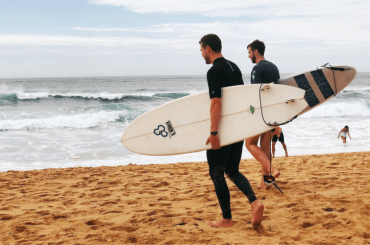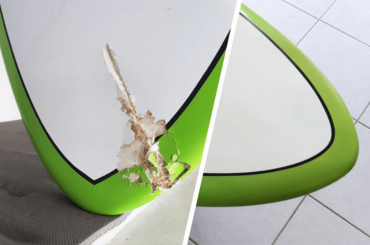If you’re a surfer, then you know that waxing your surfboard is an important part of the process.
But have you ever wondered why we do it? It turns out that there are a few benefits to waxing your board and in this blog post we’re going to discuss what they are.
So if you’re curious about waxing your board, keep reading!
Why Do Surfers Wax Their Surfboards?
There are a few reasons why surfers wax their boards.
- It makes the board more slippery, which helps the surfer move around on the board more easily.
- It protects the board from salt water and sun damage.
- The third reason is that it makes the board easier to clean.
- Waxing also gives the board a nice shine and can make it look new again.
- Waxing is an important part of taking care of a surfboard and helps to keep the board in good condition for longer.
It is also important to make sure that you use the right kind of wax for the conditions that you will be surfing in.
Benefits of Using Surf Wax on Surfboards
There are many benefits of using wax on a surfboard.
- Wax can help to improve grip and traction on the surfboard, which can help beginner surfers stay on their board and avoid wipeouts.
- Wax can also help to protect the surfboard from wear and tear.
- Wax can also make the surfboard more hydrodynamic, which can help experienced surfers catch waves more easily and ride them for longer periods.
- It helps to keep the board free of dirt and grime.
- Finally, wax can simply make the surfboard look better by the protective coating.
Drawbacks of Using Wax on Surfboards
- Wax can be difficult to apply evenly, and if it’s not applied correctly, it can create a bumpy surface that will make it harder to surf.
- Wax can also attract dirt and grime, which can make your board look dirty even after you’ve just waxed it.
- Wax can be messy and difficult to remove, especially if it’s been on the board for a while. It can also build up over time, making the board harder to clean.
- If you’re not careful, you can also end up with wax on your clothes or in your hair.
- Finally, some people are allergic to certain types of wax, so it’s always best to test a small area before applying it to the whole board.
Which Types Of Waxes Better For Surfboards?
There are different types of waxes available for surfboards, each with its advantages and disadvantages.
1- Paraffin Wax: This is the most common type of wax used on surfboards. Paraffin wax can come in a variety of colors, though clear or white are the most popular.
2- Synthetic/Polymer Waxes: These types of waxes are more expensive than paraffin wax, but they last longer. Synthetic or polymer waxes are also more effective in warm water temperatures.
3- Natural Waxes: These include beeswax and vegetable oils. Natural waxes are environmentally friendly but can be more difficult to apply evenly to a surfboard.
4- Wax Combinations: Some waxes combine two or more of the above types of waxes. These combinations can offer the best of both worlds in terms of price and performance.
Which Surf Wax are Essential for Surfboards?
Why Basecoat Wax is Important?
Basecoat wax is a type of wax that is applied to the bottom of the surfboard. It helps to protect the board from scratches and dings.
Basecoat wax is important because it helps to create a smooth surface for the paint to adhere to.
It also provides a barrier between the paint and the environment, which can help to protect the paint from damage.
Why Topcoat Wax is Important for Surfboards?
Topcoat wax is a type of wax that is applied to the top of the surfboard. It helps to protect the board from UV rays and sun damage.
Topcoat wax is important because it helps to create a smooth and shiny surface.
It also provides a barrier between the board and the environment, which can help to protect the board from damage.
When And How to Wax Your Surfboard?
There are a few things to consider when deciding when to wax your surfboard.
- The first is the temperature of the water you’ll be surfing in. If the water is cold, you’ll want to wax your board more often to prevent it from drying out and becoming brittle.
- The second is the type of waves you’ll be surfing. If you’re going to be surfing in big, powerful waves, you’ll want to make sure your board is thoroughly waxed so it doesn’t get damaged.
- Generally speaking, you should wax your board at least once a month and more frequently if you live in a warm climate or surf in salt water.
- As for the best conditions for waxing, you should do it in a warm room (around 20-25 degrees Celsius is ideal) and make sure the surface of the board is clean and dry before you start.
Steps to Apply Wax to Your Surfboard?
- The most common method is to rub the wax on with your hands, using circular motions to cover the entire surface of the board.
- Another method is to use an applicator, such as a sponge or brush, to spread the wax evenly over the board.
- When applying wax, you want to start in the middle of the board and work your way outwards in circular motions.
- Once the entire board is covered, you can use your hands or a comb to smooth out the wax and make sure it’s evenly distributed.
- Once you’ve waxed the board, it’s best to leave it in a warm place to dry for at least an hour before using it.
- You can also use a hairdryer on a low setting to speed up the drying process.
FAQs – Why Wax Surfboard?
Is it Possible to Surf Without Wax?
It is possible to surf without wax, but it significantly decreases the performance of the board and makes it more difficult to stay on the board.
Wax keeps the board slippery so that it can glide across the water more easily.
It also provides traction so that you can keep your feet on the board while riding waves.
Can You Apply Wax in the Sun?
It is not recommended to apply wax in the sun because the heat will cause the wax to melt and become difficult to spread evenly.
It is best to apply wax in a cool, shady area.
What is Surf Wax Made of?
The main ingredient in surf wax is paraffin, which is a type of wax that comes from petroleum. Paraffin is used because it’s cheap and it has a high melting point, which means it won’t melt in the sun or on your board. Other ingredients include beeswax and resin.
Final Words
Surfers wax their boards to increase the speed and glide of the board across the water. The right wax can also help a surfer stay on top of a wave for longer.
Waxing your surfboard is an easy way to improve your surfing experience.





